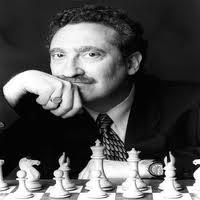
Pandolfini's Puzzler #11 - All the King's Knights
“I’ve been thinking a lot about knights recently,” said Professor Pando to an attentive Zephyr.
---
“The other day I came upon an interesting problem in a math book. It asked the reader to calculate the number of knights that could be positioned on a clear chessboard in a definite way. Funny thing is, it gave the wrong answer.”
---
Question: How many knights can you place on an empty chessboard so that no knight is in position to capture any other knight?
---
Zephyr wasn’t sure she understood the problem. But as she started to ponder a bit more, she got the idea.
---
“May I try a few possibilities on an actual board?” Zephyr asked.
---
The professor preferred it when students tried to do things in their heads. After all, in real chess games, opponents don’t let you move pieces around to see what works and what doesn’t work before playing your next move. But it was time for an exception.
---
“Sure,” the professor relented. “Go right ahead, if you think it will help you.”
---
So Zephyr cleared a chessboard and began using all the pieces, as if each one was a black knight, even white pawns and pieces, because there weren’t enough black knights to use as markers.
---
After some time, shifting markers this way and that, she thought she had arrived at an answer. Zephyr had arranged three rows of knights. She had filled up the a-file, the d-file, and the h-file with substitute knights.
---
“The answer is 24,” she said with some confidence.
---
Here’s what it would have looked like if she had a bucket of knights to use.
---
---
The Professor wasted no time in responding:
---
“No, that’s wrong. But it is the same wrong answer given by the math book.”
---
Zephyr seemed dumbfounded. Then, as people often do, she tried to defend her answer.
---
“I know it’s possible to place the knights on different files and ranks, other than the lines I’ve used here,” Zephyr shot back.
---
“Is that what you mean by saying that it’s wrong?”
---
“No, that is not what I mean,” retorted the Professor.
---
“Let me give you a clue. Whatever color square a knight starts on, it must move to a destination square of the other color. So, if it starts on a light square, it must move to a dark square. If it starts on a dark square, it must move to a light square.”
---
For an instant, Zephyr continued to look perplexed. But then her face began to beam.
---
“I understand completely now. I love this problem. It’s so elegant.” Zephyr liked using big words.
---
“May I be allowed to elucidate?” Zephyr asked.
---
What was Zephyr’s answer and why did she think it was so elegant?
---
Answer Below - Try to solve ProfessorPando's puzzle first!
---
ANSWER #11
---
Zephyr’s answer was 32, and she actually had two different correct answers. The knights could be placed entirely on light squares, or entirely on dark squares.
-
---
Why did Zephyr call the problem elegant? Because the correct answer was based on a concept. It didn’t need a practical illustration.
---
Take note
---
Many problems are solved by first trying out specific solutions, to see if they work. But there’s an entire class of problems that can be better solved by first getting a good idea that takes into account all the possible solutions. Scientists, mathematicians, and chess players, at different times, use both methods. When calculating variations, chess players tend to get specific. When making plans, chess players tend to get general.
---
Of course, good chess play requires that players do both. And the best plans are always supported by concrete and specific analysis.
----
RELATED STUDY MATERIAL
- Watch PlayfulSquirrel's video on using knights in the endgame;
- Check out our entire library of videos on how to use knights properly.






